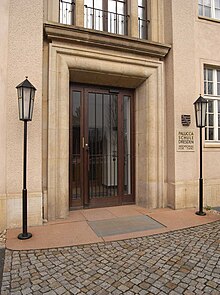Cotta sandstone

The Cotta sandstone ; also known as the central cuboid , can be found both in the Elbe valley and in numerous side valleys. Its main occurrence is in the west of the Elbe Sandstone Mountains , which stretch as far as the Bohemian border. It is named after the Cotta district of Dohma , a stone quarrying area. The Cotta sandstone originated in the chalk , in the lower Turon .
Formation and nature of the rock
The colors of this Elbe sandstone can be whitish, gray, grayish yellow and brownish. The Cotta sandstone is medium-grained in the south and fine-grained in the north. Around the town of Cotta the grain is evenly large with 0.1 to 0.22 millimeters and only very rarely up to 0.3 millimeters. The rock contains the smallest mica mineral parts (glauconite), clayey and carbonaceous substances. The coal particles are deposited in clearly recognizable veins. They sometimes resemble marble textures .
The technical values of this natural stone fluctuate greatly, as the quartz grains of the Cotta sandstone are mainly bound in pebbles , but it has many unevenly distributed deposits of the phyllosilicate illite and kaolinite .
Dismantling
The stone was mined in Dohma (Groß-Cotta), Bad Gottleuba-Berggießhübel in the districts of Gottleuba and Berggießhübel and Langenhennersdorf, and also in Rottwerndorf , Neundorf and Lohmgrund in the south of Pirna ; also in Gersdorf , Bahretal (Ottendorf) and in the Krippenbachtal . The dismantling of the Elbe sandstones is technically facilitated by the division of the benches with changing thicknesses and crevices, since the crevices are perpendicular and the benches are approximately perpendicular to them. This makes it possible to break right-angled blanks. The depth of the mineable sandstone banks varies from 0.5 to 3 meters. The thickness of the Cotta sandstone deposit varies between 50 and 80 meters.
use
General use
In the past, the sandstone quarried near Langenhennersdorf , Berggießhübel and Gersdorf, which was coarser-grained there, was not only processed into building or stone carving stone, but also into millstones. Cotta sandstone is used today (2008) for massive window and door framing, stone carving and profiled stone carving and is mainly used for restorations, sometimes also for new buildings.
Cultural meaning
The Cotta sandstone is of great cultural importance, because in the past, elaborate and filigree stone carving and sculptural ornaments were often used and shaped from this natural stone, since the Cotta sandstone is a popular stone sculptor because of its easy malleability . Extremely fine-grained workpieces are selected for the stone carving work. The Cotta sandstone is a frequently used sculptural stone to this day.
The Cotta sandstone was used as structural decoration in Dresden on the Zeughaus and Zwinger , in Leipzig on the Imperial Court Building and Stock Exchange and on the Hamburg City Hall , in Berlin at the former Berlin University of Fine Arts , at the Berlin City Palace for building sculpture, at the Technical University Berlin , on Pergamon Museum and at the Tietz department store (today KaDeWe).
- Art-historical use of Cotta stone
See also
literature
- W. Dienemann and O. Burre: The usable rocks of Germany and their deposits with the exception of coal, ores and salts, Enke-Verlag, Stuttgart 1929.
- Siegfried Grunert: The Elbe sandstone: occurrence, use, properties . In: Geologica Saxonica Journal of Central European Geology 52/53 (2007), pp. 143–204 ( digitized version ; PDF; 609 kB)
Web links
- Technical values of the Cotta sandstone
- Information about the Elbe sandstone
- Surface of the Cotta sandstone (sculptor quality)





